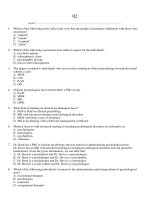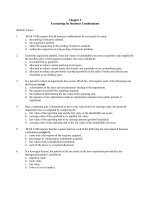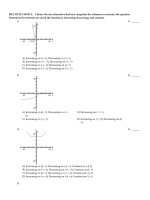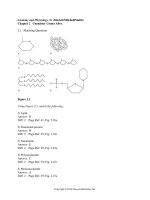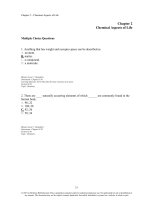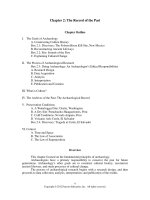Focus on personal finance 5th edition kapoor test bank
Bạn đang xem bản rút gọn của tài liệu. Xem và tải ngay bản đầy đủ của tài liệu tại đây (403 KB, 84 trang )
Chapter 02
Money Management Skills
True / False Questions
1.
Money management refers to day-to-day financial activities necessary to manage current personal
economic resources while working toward long-term financial security.
True
2.
False
Money management refers to annual financial activities necessary to manage personal economic
resources.
True
False
3.
An organized system of financial records provides a basis for reducing credit card usage.
True
4.
False
A budget is a record of how a person or family has spent their money.
True
False
2-1
Copyright © 2016 McGraw-Hill Education. All rights reserved. No reproduction or distribution without the prior written consent of
McGraw-Hill Education.
5.
Programs are available to help low-income people around the world improve their money
management skills or financial literacy.
True
False
6.
In an organized system of financial records, credit card records belong in a safe deposit box.
True
False
7.
In an organized system of financial records, birth and marriage certificates belong in a safe deposit
box.
True
False
8.
In an organized system of financial records, medical information belongs in a home file.
True
False
9.
Financial documents that you may need quick access to should be kept in a safe deposit box.
True
False
2-2
Copyright © 2016 McGraw-Hill Education. All rights reserved. No reproduction or distribution without the prior written consent of
McGraw-Hill Education.
10.
In an organized system of financial records, investment records belong in a home file, home
computer, or online.
True
False
11.
Copies of tax returns and supporting data should be saved for 10 years.
True
False
12. Birth certificates, wills, and Social Security data should be kept for up to 7 years.
True
False
13.
The two personal financial statements that you create yourself are the personal balance sheet and
a credit card payoff statement.
True
False
14. The current financial position of an individual or family is a common starting point for financial
planning.
True
False
15. Net worth is the amount owed to others.
True
False
2-3
Copyright © 2016 McGraw-Hill Education. All rights reserved. No reproduction or distribution without the prior written consent of
McGraw-Hill Education.
16. Current liabilities are the debts you must pay within a short time, usually less than a year.
True
False
17.
Liquid assets can be easily converted to cash and include money in checking accounts and
personal possessions.
True
False
18. A cash flow statement uses this equation: Assets - Liabilities = Net worth.
True
False
19.
A cash flow statement uses this equation: Total cash received during the time period - Cash
outflows during the time period = Cash surplus (or deficit).
True
False
20.
When completing a cash flow statement, deductions are subtracted from gross salary to determine
take-home pay.
True
False
21.
When completing a cash flow statement, take-home pay less deductions equals gross salary.
True
False
2-4
Copyright © 2016 McGraw-Hill Education. All rights reserved. No reproduction or distribution without the prior written consent of
McGraw-Hill Education.
22. Financial advisers suggest that an emergency fund should cover one to two months of living
expenses.
True
False
23. When creating a budget, it is important to save the amount you have left at the end of the month.
True
False
24.
One method to spend more money is to deduct an amount automatically from your salary in a
direct deposit system.
True
False
25.
One method to save more money is to write a check each payday and deposit it in a separate
savings account.
True
False
26.
Annual investment account statements should be shredded.
True
False
27.
A mortgage is an amount borrowed to buy a tv or other personal possession.
True
False
2-5
Copyright © 2016 McGraw-Hill Education. All rights reserved. No reproduction or distribution without the prior written consent of
McGraw-Hill Education.
28.
If a household has $195,000 of assets and $75,000 of liabilities, then their net worth would be
$125,000.
True
False
29.
A balance sheet reports what an individual or family owns and owes.
True
False
30.
A high debt ratio is best.
True
False
Multiple Choice Questions
31. Money management refers to
A. Preparing personal financial statements.
B. Day-to-day financial activities.
C. Trade-offs that occur with financial decisions.
D. Storing financial records for easy access.
E. Spending money on current living expenses.
2-6
Copyright © 2016 McGraw-Hill Education. All rights reserved. No reproduction or distribution without the prior written consent of
McGraw-Hill Education.
32.
Which of the following is a component of money management?
A.
Storing and maintaining personal financial records and documents.
B.
Creating a balance sheet.
C.
Creating and implementing a plan for spending and saving.
D.
Creating a cash flow statement.
E.
All of the above are components of money management.
33.
A home file should be used to keep
A. All financial documents and records.
B. Financial records for current needs.
C. Documents that require maximum security.
D. Obsolete financial documents.
E. Records that are difficult to replace.
2-7
Copyright © 2016 McGraw-Hill Education. All rights reserved. No reproduction or distribution without the prior written consent of
McGraw-Hill Education.
34.
Which of the following financial documents would most likely be stored in a safe deposit box or
fireproof home safe?
A. W-2 forms
B. Personal financial statements
C. Warranties
D. Marriage certificates
E.
Bank statements
35. Which of the following is most correct?
A. A current budget belongs in your safe deposit box.
B. A warranty belongs in a safe deposit box.
C. Adoption papers belong in a home file.
D. A death certificate should be kept in a home file.
E. Tax records belong in a home file.
F. A current budget belongs in your safe deposit box.
G. Adoption papers belong in a home file.
36. Which of the following is most correct?
A. Rare coins and stamps belong in a safe deposit box.
B. A marriage certificate should be kept in a home file.
C. W-2s for tax records belong in a safe deposit box.
D. A current budget belongs in your safe deposit box.
E. Adoption papers belong in a home file.
2-8
Copyright © 2016 McGraw-Hill Education. All rights reserved. No reproduction or distribution without the prior written consent of
McGraw-Hill Education.
37. Brokerage statements are an example of a(n) ____________ record.
A. investment
B. insurance
C. estate planning
D. tax
E. consumer purchase
38. The number of personal financial records a household has to organize may seem overwhelming.
How long should you keep copies of your tax returns?
A. Until you receive your refund
B. Until the end of the current year
C. Three years
D. Seven years
E. Permanently
39. The number of personal financial records a household has to organize may seem overwhelming.
How long should you keep documents relating to the purchase and sale of real estate?
A. Until the mortgage is paid off
B. Until you move out of the house
C. Three years
D. Seven years
E. Indefinitely
2-9
Copyright © 2016 McGraw-Hill Education. All rights reserved. No reproduction or distribution without the prior written consent of
McGraw-Hill Education.
40. How long should you keep documents relating to investments?
A. No need to since the broker probably has a copy.
B.
As long as you these items.
C. Seven years.
D. Ten years.
E. Permanently.
41. How long should you keep your most current will?
A. No need to keep it since your lawyer probably has a photocopy.
B. One year.
C. Three years.
D. Seven years.
E. Permanently.
42. The main purposes of personal financial statements are to
A. Report your current financial position.
B. Measure your progress toward financial goals.
C. Maintain information about your financial activities.
D. Provide data for preparing tax forms or applying for credit.
E.
All of the above are correct
2-10
Copyright © 2016 McGraw-Hill Education. All rights reserved. No reproduction or distribution without the prior written consent of
McGraw-Hill Education.
43.
Which of the following are two personal financial statements that you create yourself?
A. Budget and credit card statements
B. Personal balance sheet and cash flow statement
C. Checkbook and budget
D. Tax returns
E.
Bank statement and a balance sheet
44.
A personal balance sheet reports
A. Amounts budgeted for spending.
B. Income and expenses for a period of time.
C. Earnings on savings and investments.
D. Items owned and amounts owed.
E. Family financial goals.
45. The current financial position of an individual or family is best presented with the use of a
A. Budget.
B. Cash flow statement.
C. Balance sheet.
D. Bank statement.
E. Time value of money report.
2-11
Copyright © 2016 McGraw-Hill Education. All rights reserved. No reproduction or distribution without the prior written consent of
McGraw-Hill Education.
46. Another name for a statement of financial position is a
A. Balance sheet.
B. Bank statement.
C. Budget.
D. Cash flow statement.
E. Time value of money report.
47. The statement that includes liquid assets, real estate, personal possessions, and investment assets
is known as a
A. Personal balance sheet.
B. Bank statement.
C. Budget.
D. Cash flow statement.
E. Time value of money report.
48. Items with monetary value are referred to as
A. Liabilities.
B. Variable expenses.
C. Net worth.
D. Income.
E. Assets.
2-12
Copyright © 2016 McGraw-Hill Education. All rights reserved. No reproduction or distribution without the prior written consent of
McGraw-Hill Education.
49.
Which of the following is a liquid asset?
A. Savings/money market accounts
B. Cash value of life insurance
C. Checking account balance
D.
Money market accounts
E.
All of the above are liquid assets
50. When creating a personal balance sheet, which of the following is a real estate asset?
A. Cash value of life insurance
B. Vacation property
C. Possessions in your home
D.
Investments for financing children’s education
E.
Retirement accounts
2-13
Copyright © 2016 McGraw-Hill Education. All rights reserved. No reproduction or distribution without the prior written consent of
McGraw-Hill Education.
51. When creating a personal balance sheet, which of the following is considered to be a personal
possession asset?
A. A five-year-old television set
B. A home
C. Cash in a checking account
D.
Retirement accounts
E. Vacation property
52. When creating a personal balance sheet, which of the following is an investment asset?
A. Cash value of life insurance
B. Checking account
C.
Personal possessions in your home
D. Retirement account
E. Vacation property
53. When creating a personal balance sheet, which of the following is a current liability?
A. Checking account
B.
Mortgage
C.
Educational loan
D.
Auto loan
E.
Medical bill
2-14
Copyright © 2016 McGraw-Hill Education. All rights reserved. No reproduction or distribution without the prior written consent of
McGraw-Hill Education.
54.
The amount you would have left if all assets were sold and all debts were paid in full is called your
A. Net assets.
B. Net worth.
C. Total liabilities.
D. Total income.
E. Budgeted expenses.
55. The equation to calculate net worth is
A. Assets - Cash outflows = Net worth.
B. Cash inflows - Liabilities = Net worth.
C. Cash inflows - Cash outflows = Net worth.
D. Assets - Liabilities = Net worth.
E. Cash inflows + Liabilities = Net worth.
56.
The inability to pay debts when they are due because liabilities far exceed the value of assets is
called
A. Liabilities.
B. Insolvency.
C. Net worth.
D. Cash flow.
E. Liquid assets.
2-15
Copyright © 2016 McGraw-Hill Education. All rights reserved. No reproduction or distribution without the prior written consent of
McGraw-Hill Education.
57. Which of the following situations describes a person who could be insolvent?
A. Assets $56,000; annual expenses $60,000
B. Assets $78,000; net worth $22,000
C. Liabilities $45,000; net worth $6,000
D. Assets $40,000; liabilities $55,000
E. Annual cash inflows $45,000; liabilities $50,000
58. All of the following are ways that households can increase their net worth except
A. Increase their savings.
B. Reduce spending.
C. Increase value of investments.
D. Reduce amounts owed.
E. Increase their debt ratio.
59. Which of the following will increase the net worth of a household?
A. Decrease saving by $50 per month
B. Increase the amount borrowed for major purchases
C. Decrease spending by $5 per day
D. Invest in possessions whose values do not increase
E.
Increase spending by $5 per day
2-16
Copyright © 2016 McGraw-Hill Education. All rights reserved. No reproduction or distribution without the prior written consent of
McGraw-Hill Education.
60. Which of the following is a cash inflow?
A.
Payment for rent
B.
Purchase of groceries
C.
Payment for loan
D.
Income from employment
E.
Payment for medical expenses
61. Which of the following appears as a cash outflow on a cash flow statement?
A. Liquid assets
B. Variable expenses
C. Net worth
D. Personal possessions
E. Real estate assets
62. Which of the following appears as a cash outflow on a cash flow statement?
A. Home value
B. Loan payment
C. Net worth
D. Balance of mortgage
E. Cash value of life insurance
2-17
Copyright © 2016 McGraw-Hill Education. All rights reserved. No reproduction or distribution without the prior written consent of
McGraw-Hill Education.
63. Financial experts recommend monthly savings of ____ of gross income.
A. 0%
B. 5-10%
C. 20%
D. 25-35%
E. 50%
64. Financial experts recommend a debt/payments ratio of less than ____ of take-home pay.
A. 0%
B. 5-10%
C. 20%
D. 25-35%
E. 50%
65. A current ratio of 2 means
A. 2% from each paycheck is available for savings.
B. The minimum payment for a credit card is 2% of the balance.
C. 2 months of living expenses are available in case of emergency.
D. Net worth equals 2 times the amount of debt.
E.
$2 in liquid assets are available for every $1 of current liabilities.
66. A debt ratio of 0.5 indicates
A. The balance on the mortgage = 50% of the value of the home.
B. For every dollar of net worth, debt equals $0.50.
C. For every dollar of debt, net worth equals $0.50.
D. For every dollar of take-home pay, monthly credit payments equal $0.50.
E. For every dollar of assets, monthly credit payments equal $0.50.
2-18
Copyright © 2016 McGraw-Hill Education. All rights reserved. No reproduction or distribution without the prior written consent of
McGraw-Hill Education.
67. Which of the following ratios shows the relationship between debt and net worth?
A. Debt ratio
B. Current ratio
C. Household ratio
D. Debt payments ratio
E. Savings ratio
68. Which of the following ratios indicates that liquid assets are available to pay current liabilities for a
household?
A. Debt ratio
B. Current ratio
C. Liquidity ratio
D. Debt payments ratio
E. Savings ratio
69. Which of the following ratios indicates the number of months in which living expenses can be paid
if an emergency arises?
A. Debt ratio
B. Current ratio
C. Liquidity ratio
D. Debt payments ratio
E. Savings ratio
2-19
Copyright © 2016 McGraw-Hill Education. All rights reserved. No reproduction or distribution without the prior written consent of
McGraw-Hill Education.
70. Which of the following ratios indicates the amount of a person's earnings that goes for payments
for credit cards, auto loans, and other debt (except mortgage)?
A. Debt ratio
B. Current ratio
C. Liquidity ratio
D. Debt payments ratio
E. Savings ratio
71. Which of the following ratios shows the relationship between gross income and money saved?
A. Debt ratio
B. Current ratio
C. Liquidity ratio
D. Debt payments ratio
E. Savings ratio
72. All of the following are sources of income except
A.
Interest earned on savings
B.
Commissions
C. Dividends
D. Salary
E. Social Security taxes
2-20
Copyright © 2016 McGraw-Hill Education. All rights reserved. No reproduction or distribution without the prior written consent of
McGraw-Hill Education.
73. Which of the following is a deduction to determine take-home pay?
A.
Interest earned on savings
B. Commissions
C. Dividends
D. Salary
E. Social Security taxes
74. Disposable income equals
A. Gross income.
B.
Disposable income.
C. The amount being saved each month.
D. Money left over after paying for housing, food, and other necessities.
E. Social Security taxes.
75. Discretionary income equals
A. Gross income.
B. Take-home pay.
C. The amount being saved each month.
D. Money left over after paying for housing, food, and other necessities.
E. Social Security taxes.
2-21
Copyright © 2016 McGraw-Hill Education. All rights reserved. No reproduction or distribution without the prior written consent of
McGraw-Hill Education.
76. The money left over after paying for housing, food, and other necessities is called
A. Monthly savings.
B. Discretionary income.
C. Disposable income.
D. Gross income.
E. Take-home pay.
77.
Take-home pay is also called
A. Monthly savings.
B. Discretionary income.
C.
Net pay.
D. Gross income.
E. Deductions.
78. An example of a variable expense is a(n)
A.
Mortgage or rent payment.
B. Installment loan payment.
C.
Monthly train ticket for commuting to work.
D.
Monthly allocation for life insurance.
E. Electric bill.
2-22
Copyright © 2016 McGraw-Hill Education. All rights reserved. No reproduction or distribution without the prior written consent of
McGraw-Hill Education.
79. All of the following are fixed expenses except a(n)
A.
Mortgage or rent payment.
B. Installment loan payment.
C.
Monthly train ticket for commuting to work.
D.
Monthly allocation for life insurance.
E.
Utilities.
80. An example of a fixed expense is
A. Medical expenses.
B. Gifts.
C. Utilities.
D.
A mortgage payment.
E. Recreation.
81. Which of the following is NOT a main purpose of a budget?
A. Help to live within your income
B. Spend your money without care
C. Reach financial goals
D. Prepare for financial emergencies
E. Develop wise financial management habits
2-23
Copyright © 2016 McGraw-Hill Education. All rights reserved. No reproduction or distribution without the prior written consent of
McGraw-Hill Education.
82. When creating a budget, which of the following statements is true?
A. Include in income the bonuses and gifts you expect to receive.
B. It is easier to create a budget if your earnings vary by season.
C. Common financial problems can be maximized through budgeting.
D. Numbers in the budget are estimates.
E. It is better to overestimate your income for next year.
83. When creating a budget, it is important to
A. Save the amount you have left at the end of the month.
B. Set aside savings after your variable expenses are paid.
C. Save an amount no more than 3% of your annual income in an emergency fund.
D. Spend the amount of money you have budgeted in each category.
E. "Pay yourself first" by setting aside savings before other expenses are budgeted.
84. The difference between the amount budgeted and the actual amount received or spent is called
the
A. Budget variance.
B. Cash outflow.
C. Income.
D. Cash inflow.
E. Variable expense.
2-24
Copyright © 2016 McGraw-Hill Education. All rights reserved. No reproduction or distribution without the prior written consent of
McGraw-Hill Education.
85. A budget deficit would result when a person's or family's
A.
Actual spending is less than planned spending.
B. Assets exceed liabilities.
C.
Actual spending equals planned spending.
D.
Actual spending exceeds planned spending.
E. Net worth decreases.
86.
After having established a spending plan, it is important to
A. File the budget in a safe deposit box.
B. Compare it to the previous budget.
C.
Keep track of your actual income and expenses.
D. Pay attention only to expenses that are more than 10 percent of your salary.
E. None of these are true since budgets are just estimates.
87. When household budgets must be cut, which of the following categories would be most difficult to
cut?
A. Vacations
B. Lawn services
C. Cable
D. Charitable donations
E. Auto insurance
2-25
Copyright © 2016 McGraw-Hill Education. All rights reserved. No reproduction or distribution without the prior written consent of
McGraw-Hill Education.
